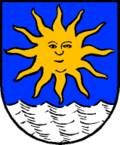This article needs additional citations for verification .(October 2023) |
St. Gilgen St. Gieng | |
|---|---|
 | |
| Coordinates: 47°46′00″N13°22′00″E / 47.76667°N 13.36667°E | |
| Country | |
| State | Salzburg |
| District | Salzburg-Umgebung |
| Government | |
| • Mayor | Otto Kloiber (ÖVP) |
| Area | |
• Total | 98.72 km2 (38.12 sq mi) |
| Elevation | 545 m (1,788 ft) |
| Population (2018-01-01) [2] | |
• Total | 3,915 |
| • Density | 40/km2 (100/sq mi) |
| Time zone | UTC+1 (CET) |
| • Summer (DST) | UTC+2 (CEST) |
| Postal code | 5340 |
| Area code | +43 6227 |
| Vehicle registration | SL |
| Website | www.gemgilgen.at |
St. Gilgen (Central Bavarian: St. Gieng) is a village by Lake Wolfgang in the Austrian state of Salzburg, in the Salzkammergut region.






